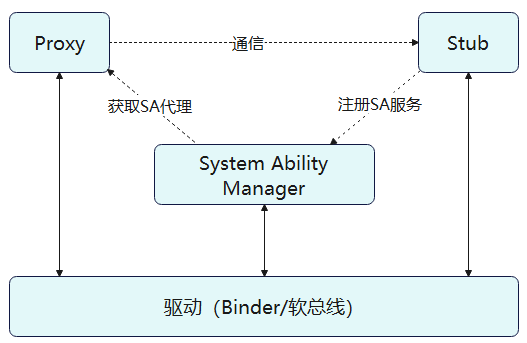# 简介
对于 OpenHarmony 的 IPC 框架,每个部件都需要用到。本文将介绍 OpenHarmony 的进程间通信原理,并提供相应的代码示例。
IPC 和 RPC 通常采用客户端 - 服务器(Client-Server)模型,在使用时,请求服务的(Client)一端进程可获取提供服务(Server)一端所在进程的代理(Proxy),并通过此代理读写数据来实现进程间的数据通信。

# 开发步骤
# iService
定义 IPC 接口类,表示 IPC 提供的功能。
继承 IRemoteBroker ,且通过 DECLARE_INTERFACE_DESCRIPTOR 定义描述符。
提供的 IPC 业务函数写成纯虚函数。业务函数在 Proxy 端和 Stub 端都需要实现。
class ITestAbility : public IRemoteBroker { | |
public: | |
DECLARE_INTERFACE_DESCRIPTOR(u"test.ITestAbility"); | |
virtual int TestPingAbility(const std::u16string &dummy) = 0; // 定义业务函数 | |
}; |
# Proxy
proxy 是在 Client 侧负责与 Service 侧进行通信的中间类。主要负责将 Client 的数据进行编码发送到 Service 侧的 Stub。
proxy 需要继承 IRemoteProxy<ITestAbility> ,其中模板参数为我们上一步定义的接口类。
proxy 需要包含一个 BrokerDelegator<TestAbilityProxy> 的静态成员,自动接管我们的功能,而不需要手动注册。
proxy 通过 SendRequest 将 IPC_CODE 和封装好的参数 发到 Service 端的 Stub。
class TestAbilityProxy : public IRemoteProxy<ITestAbility> { | |
public: | |
explicit TestAbilityProxy(const sptr<IRemoteObject> &impl); | |
int TestPingService(const std::u16string &dummy) override; | |
private: | |
static inline BrokerDelegator<TestAbilityProxy> delegator_; // 方便后续使用 iface_cast 宏 | |
} | |
TestAbilityProxy::TestAbilityProxy(const sptr<IRemoteObject> &impl) | |
: IRemoteProxy<ITestAbility>(impl) | |
{ | |
} | |
int TestAbilityProxy::TestPingService(const std::u16string &dummy){ | |
MessageOption option; | |
MessageParcel dataParcel, replyParcel; | |
dataParcel.WriteString16(dummy); | |
int error = Remote()->SendRequest(TRANS_ID_PING_ABILITY, dataParcel, replyParcel, option); | |
int result = (error == ERR_NONE) ? replyParcel.ReadInt32() : -1; | |
return result; | |
} |
# Stub
Stub 作为接收请求的一端,需重写 OnRemoteRequest 方法用于接收客户端调用。可以通过向 reply 写数据,直接回传数据。
可以看到 Stub 也继承了 ITestAbility,所以 Stub 也可以重写 TestPingAbility 的方法。
class TestAbilityStub : public IRemoteStub<ITestAbility> { | |
public: | |
virtual int OnRemoteRequest(uint32_t code, MessageParcel &data, MessageParcel &reply, MessageOption &option) override; | |
int TestPingAbility(const std::u16string &dummy) override; //stub 可以不实现 | |
}; | |
int TestServiceStub::OnRemoteRequest(uint32_t code, | |
MessageParcel &data, MessageParcel &reply, MessageOption &option) | |
{ | |
switch (code) { | |
case TRANS_ID_PING_ABILITY: { | |
std::u16string dummy = data.ReadString16(); | |
int result = TestPingAbility(dummy); | |
reply.WriteInt32(result); | |
return 0; | |
} | |
default: | |
return IPCObjectStub::OnRemoteRequest(code, data, reply, option); | |
} | |
} |
# Service
本质上 Service 就是一个 Stub,只不过一般会把业务和 IPC 处理分离,业务写在 Service 里,编解码相关的 IPC 写在 Stub 中。实现业务与 IPC 解耦。
Service 会实现 接口类的所有业务函数。
class TestAbility : public TestAbilityStub, public SystemAbility { | |
public: | |
int TestPingAbility(const std::u16string &dummy) override; | |
} | |
int TestAbility::TestPingAbility(const std::u16string &dummy) { | |
return 0; | |
} |